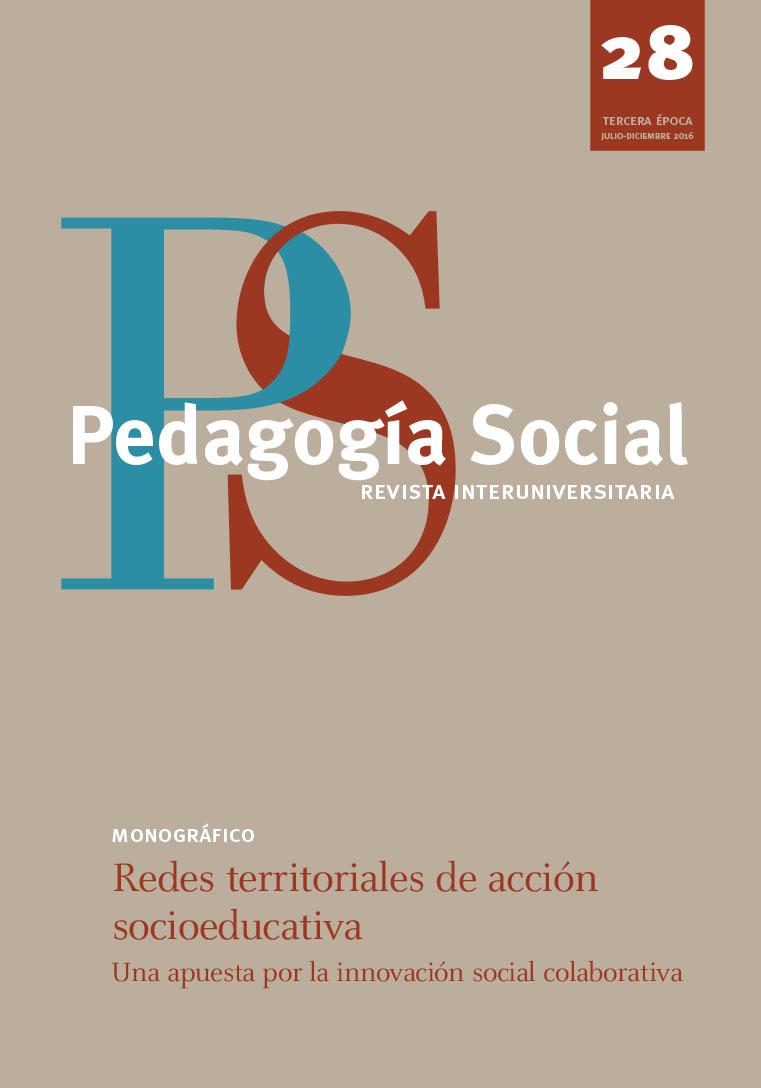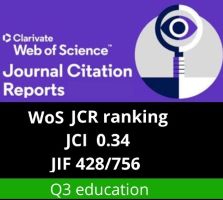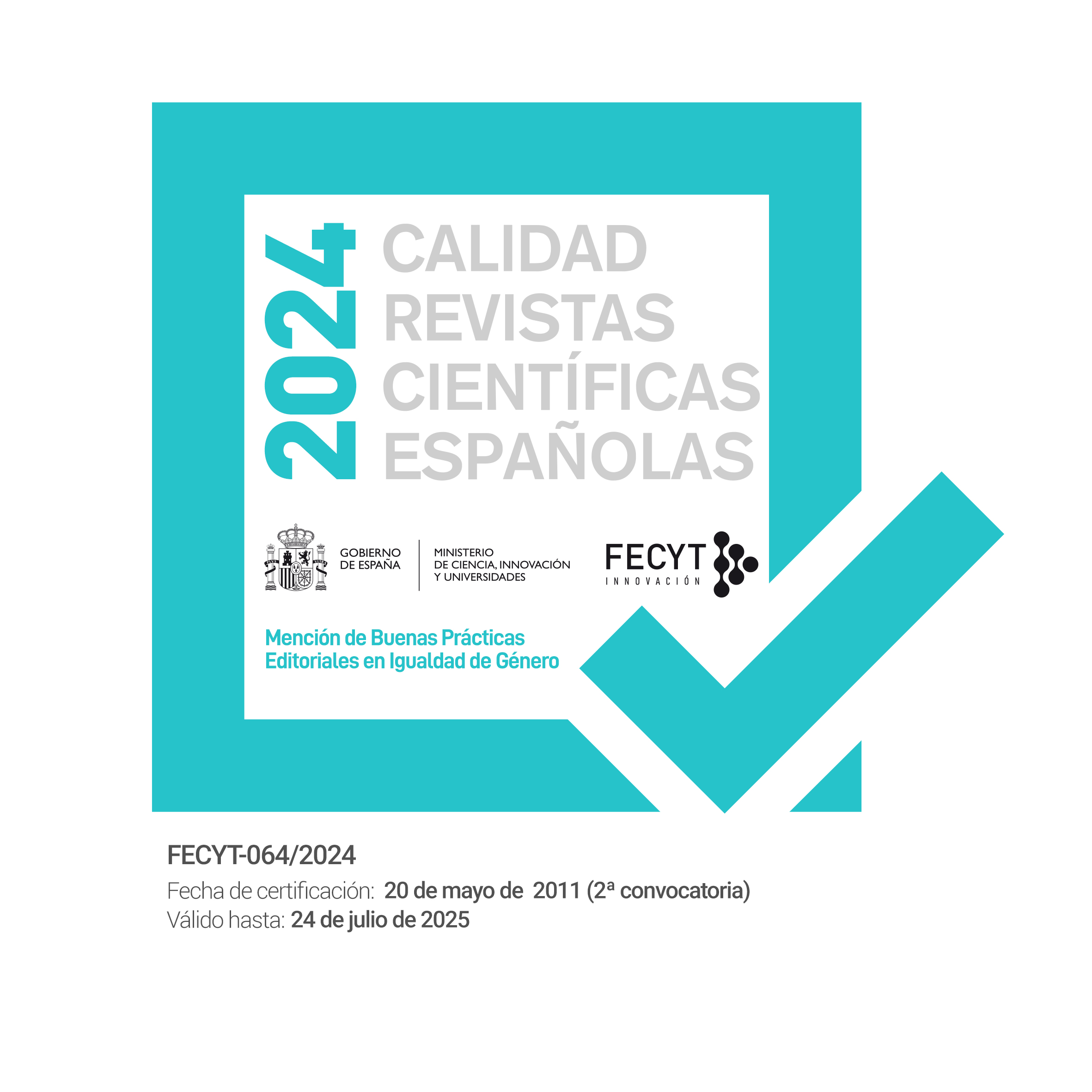Conexiones de valor: una perspectiva del capital social sobre las redes sociales de profesores, el compromiso y la autoeficacia
DOI:
https://doi.org/10.7179/PSRI_2016.28.06Palabras clave:
capital social, redes sociales, compromiso, autoeficacia, rendimiento escolarResumen
En la investigación sobre la aplicación de la reforma educacional, los investigadores han subrayado la importancia que la colaboración entre profesores tiene en el rendimiento escolar. En el presente estudio se examina si el intercambio de conocimiento en las redes sociales entre profesores tiene relación con los elementos esenciales asociados al aumento del rendimiento escolar, a saber: la autoeficacia y el compromiso de los profesores. Desde el punto de vista de la teoría del capital social, estudiamos las redes sociales de profesores para valorar si el mayor acceso a los recursos tiene relación con un mayor sentido de la eficacia y el compromiso en los docentes. Recopilamos encuestas y datos del entorno social de ocho escuelas primarias en los Países Bajos (N=114), que fueron comparados utilizando análisis correlacional y análisis de redes sociales. los resultados sugieren relaciones positivas entre los indicadores de las redes de profesores, la autoeficacia y el compromiso con la organización y con los estudiantes. Nuestras conclusiones abren el camino a posteriores instrumentos de política educativa orientados al estudio relacional.
Descargas
Citas
Balkundi, P. & Harrison, D. (2006). Ties, leaders, and time in teams: strong inferences about network structures effects on team viability and performance. Academy of Management Journal, 49, 49-68. doi:10.5465/AMJ.2006.20785500
Bandura, A. (1997). Self-efficacy: the exercise of control. New York: Freeman
Borgatti, S.P., Everett, M.G., & Freeman, L.C. (2002). Ucinet 6 for Windows: Software for Social Network Analysis. Harvard, MA; Analytic Technologies
Brookhart, S.M., & Loadman, W.E. (1990). School-university collaboration: different workplace cultures. Contemporary Education, 61, 125-128
Caprara, G. V., Barbaranelli, C., Steca, P., & Malone, P. S. (2006). Teachers' self-efficacy beliefs as determinants of job satisfaction and students' academic achievement: A study at the school level. Journal of school psychology, 44, 473-490.
Carolan, B.V. (2013). Social network analysis and education: Theory, methods and applications. Sage Publications: Thousand Oaks.
Coladarci, T. (1992). Teachers' sense of efficacy and commitment to teaching. The Journal of experimental education, 60(4), 323-337. doi:10.1080/00220973.1992.9943869
Daly, A .J., Finnigan, K., Jordan, S., Moolenaar, N.M. & Che, J. (2014). Misalignment and perverse incentives: Examining the politics of district leaders as brokers in the use of research evidence. Educational Policy, 28(2), 145-174. DOI: 10.1177/0895904813513149
Daly, A. J., Moolenaar, N.M., Der-Martirosian, C., & Liou, Y. (2014). Accessing capital resources: Investigating the effects of teacher human and social capital on student achievement. Teachers College Record, 116(7).
Daly, A.J. (2010). Social Network Theory and Educational Change. Cambridge, MA: Harvard University Press.
Daly, A.J., Moolenaar, N.M., Bolivar, J.M., & Burke, P. (2010). Relationships in reform; The role of teachers’ social networks. Journal of Educational Administration, 48, 39-79. doi:10.1108/09578231011041062
Dannetta, V. (2002). What factors influence a teacher’s commitment to student learning? Leadership and Policy in School, 1, 144-171. doi:10.1076/lpos.1.2.144.5398
Duyar, I., Gumus, S., & Sukru Bellibas, M. (2013). Multilevel analysis of teacher work attitudes: The influence of principal leadership and teacher collaboration. International Journal of Educational Management, 27(7), 700-719. doi:10.1108/IJEM-09-2012- 0107
Elliott, B., & Crosswell, L. (2002). Teacher commitment and engagement: The dimensions of ideology and practice associated with teacher commitment and engagement within an Australian perspective. Retrieved from http://www.aare.edu.au/02pap/cro02522.htm.
Fink, S.L. (1992). High commitment workplaces. New York: Quorum Books.
Firestone, W.A., & Pennell, J.R. (1993). Teacher commitment, working conditions, and differential incentive policies. Review of Educational Research, 63, 489-525. doi:10.3102/00346543063004489
Firestone, W.A., & Rosenblum, S. (1988). Building commitment in urban high schools. Educational Evaluation and Policy Analysis, 10, 285-299. doi:10.3102/01623737010004285
Frank, K. A., Zhao, Y., & Borman, K. (2004). Social capital and the diffusion of innovations within organizations: Application to the implementation of computer technology in schools. Sociology of Education, 77(2), 148–171.
Freeman, L.C. (1979). Centrality in Social Networks Conceptual Clarification. Social Networks, 1, 215-239. doi:10.1016/0378-8733(78)90021-7
Friedkin, N.E., & Slater, M.R. (1994). Social Leadership and Performance: A Social Network Approach. Sociology of Education, 67, 139-157. doi:10.2307/2112701
Gist, M. E., & Mitchell, T. R. (1992). Self-efficacy: A Theoretical analysis of its determinants and malleability. Academy of Management Review, 77, 183-211.
Haythornthwaite, C. (1996). Social network analysis: An approach and technique for the study of information exchange. Library & information science research, 18(4), 323- 342. doi:10.1016/S0740-8188(96)90003-1
Johnson, B. (2003). Teacher collaboration: Good for some, not so good for others. Educational Studies, 29(4), 337-350. doi:10.1080/0305569032000159651
Kameda, T., Ohtsubo,Y., & Takezawa, M. (1997). Centrality in socio-cognitive network and social influence: An illustration in a group decision-making context. Journal of Personality and Social Psychology, 73, 296-309. doi:10.1037/0022-3514.73.2.296
Klassen, R. M., & Chiu, M. M. (2010). Effects on teachers' self-efficacy and job satisfaction: Teacher gender, years of experience, and job stress. Journal of educational Psychology, 102(3), 741. doi:10.1037/a0019237
Lee, J. C. K., Zhang, Z., & Yin, H. (2011). A multilevel analysis of the impact of a professional learning community, faculty trust in colleagues and collective efficacy on teacher commitment to students. Teaching and Teacher Education, 27(5), 820-830. doi:10.1016/j.tate.2011.01.006
Lee, V. E., Dedrick, R. F., & Smith, J. B. (1991). The effect of the social organization of schools on teachers' efficacy and satisfaction. Sociology of Education, 64, 190-208. doi:10.2307/2112851
Lin, H. F. (2007). Effects of extrinsic and intrinsic motivation on employee knowledge sharing intentions. Journal of information science, 33, 135-149. doi:10.1177/0165551506068174
Moolenaar, N. M. (2012). A social network perspective on teacher collaboration in schools: Theory, methodology, and applications. American Journal of Education, 119(1), 7 - 39.
Moolenaar, N. M., Daly, A. J., & Sleegers, P. J. C. (2010). Occupying the principal position: Examining relationships between transformational leadership, social network position, and schools’ innovative climate. Educational Administration Quarterly, 46(5), 623-670.
Moolenaar, N. M., Daly, A. J., & Sleegers, P. J. C. (2012). Exploring patterns of interpersonal relationships among teachers: A social network perspective. In: T. Wubbels, J. van Tartwijk, P. den Brok and J. Levy (Eds.) (pp. 87-101), Interpersonal Relationships in Education (Advances in Learning Environments series). Rotterdam, The Netherlands: SENSE Publishers.
Moolenaar, N. M., Daly, A.J., Sleegers, P.J.C., & Karsten, S. (2014). The social forces of elementary school teams: How demographic composition shapes social networks. In T. Wubbels, J. van Tartwijk, P. den Brok, J. Levy, and D. Zandvliet (Eds.), Interpersonal Relationships in Education: From theory to practice (Advances in Learning Environments series). Rotterdam, The Netherlands: SENSE Publishers.
Moolenaar, N. M., Sleegers, P. J. C., & Daly, A. J. (2011). Teaming up: Linking collaboration networks, collective efficacy, and student achievement. Teaching and Teacher Education, 28(2), 251-262. DOI: 10.1016/j.tate.2011.10.001
Moolenaar, N.M., Sleegers, P.J.C., & Daly, A.J. (2012). Teaming up: Linking collaboration networks, collective efficacy, and student achievement. Teaching and Teacher Education, 28, 251-262. doi:10.1016/j.tate.2011.10.001
Moolenaar, Nienke M., Sleegers, Peter J. C., Karsten, Sjoerd, & Daly, Alan J. (2012). The social fabric of elementary schools: A network typology of social interaction among teachers. Educational Studies, 38(4), 355-371. DOI: 10.1080/03055698.2011.643101
Mowday, R.T., Steers, R.M., & Porter, L.W. (1979). The measurement of organizational commitment. Journal of Vocational Behavior, 14, 224-247. doi:10.1016/0001- 8791(79)90072-1
Nias, J. (1981). Commitment and motivation in primary school teachers. Educational Review, 33, 181-190. doi:10.1080/0013191810330302
OECD (2015). Part-time employment rate (indicator). doi: 10.1787/f2ad596c-en (Accessed on 21 July 2015)
Park, I. (2007). Teacher commitment and its effects on student achievement in American high schools. Educational Research and Evaluation, 11, 461-485. doi:10.1080/13803610500146269
Raudenbush, S. W., Rowan, B., & Cheong, Y. F. (1992). Contextual effects on the self- perceived efficacy of high school teachers. Sociology of Education, 150-167.
Reyes, P. (1990). Organizational Commitment of Teachers. In P. Reyes (Ed.), Teachers and their workplace: Commitment, performance, and productivity (pp. 143 – 162). San Francisco: Sage.
Rijksoverheid (2014). Kamerbrief over de onderwijsakkoorden: samen werken aan het onderwijs van morgen, Retrieved from http://www.rijksoverheid.nl/documenten-en- publicaties/kamerstukken/2014/08/27/kamerbrief-over-de-onderwijsakkoorden-samen- werken-aan-het-onderwijs-van-morgen.html
Roberts, K.H., & O’Reilly, C.A. (1979). Some correlations of communication roles in organizations. Academy of Management Journal, 22, 42-57. doi:10.2307/255477
Ross, J.A. (1998). The antecedents and consequences of teacher efficacy. In J. Brophy (Ed.), Advances in Research on Teaching (Vol. 7, pp. 49–74). Greenwich, CT: JAI Press.
Schunk, D. H. (1987). Peer models and children’s behavioral change. Review of educational research, 57(2), 149-174. doi:10.3102/00346543057002149
Schunk, D. H. (1989). Self-efficacy and cognitive skill learning. In C. Ames & R. Ames (Eds.), Research on motivation in education: Vol. 3. Goals and cognitions (pp. 13-44) San Diego, CA: Academic.
Schunk, D. H., & Zimmerman, B. J. (1997). Social origins of self-regulatory competence. Educational psychologist, 32(4), 195-208. doi:10.1207/s15326985ep3204_1
Schwarzer, R., Schmitz, G.S., & Daytner, G.T. (1999). The Teacher Self-Efficacy Scale [Online publication]. Retrieved from http://www.strivetogether.org/sites/default/files/ images/31%20Teacher%20Self-Efficacy_Schwarzer%20el%20al.pdf
Scott-Ladd, B., Travaglione, A., & Marshall, V. (2006). Casual inferences between participation in decision making, task attributes, work effort, rewards, job satisfaction and commitment. Leadership & Organization Development Journal, 27, 399-414. doi:10.1108/01437730610677990
Scott, C. R., Connaughton, S. L., Diaz-Saenz, H. R., Maguire, K., Ramirez, R., Richardson, B., ... & Morgan, D. (1999). The Impacts of Communication and Multiple Identifications on Intent to Leave A Multimethodological Exploration. Management Communication Quarterly, 12(3), 400-435.
Shachar, H., & Shmuelevitz, H. (1997). Implementing cooperative learning, teacher collaboration and teachers’ sense of efficacy in heterogeneous junior high schools. Contemporary educational psychology, 22, 53-72.
Siciliano, M. D. (2015). Professional Networks and Street-Level Performance How Public School Teachers’ Advice Networks Influence Student Performance. The American Review of Public Administration, 0275074015577110.
Skaalvik, E. M., & Skaalvik, S. (2010). Teacher self-efficacy and teacher burnout: A study of relations. Teaching and teacher education, 26(4), 1059-1069. doi:10.1016/j.tate.2009.11.001
Somech, A., & Bogler, R. (2002). Antecedents and consequences of teacher organizational and professional commitment. Educational Administration Quarterly, 38, 555-577. doi:10.1177/001316102237672
Spillane, J. P., Kim, C. M., & Frank, K. A. (2012). Instructional advice and information providing and receiving behavior in elementary schools: Exploring tie formation as a building block in social capital development. American Educational Research Journal, 49(6), 1112-1145.
Tschannen-Moran, M., & Hoy, A. W. (2007). The differential antecedents of self-efficacy beliefs of novice and experienced teachers. Teaching and teacher Education, 23(6), 944-956. doi:10.1016/j.tate.2006.05.003
Tsui, K.T., & Cheng, Y.C. (1991). School organizational health and teacher commitment: A contingency study with multi-level analysis. Educational Research and Evaluation, 5, 249-268. doi:10.1076/edre.5.3.249.3883
Van Waes, S., Van den Bossche, P., Moolenaar, N., De Maeyer, S., & Van Petegem, P. (accepted, 2015). Know-who? Linking faculty’s networks to stages of instructional development. Higher Education.
World Bank. (2015). Pupil-teacher ratio, primary. Retrieved from http://data.worldbank.org/indicator/SE.PRM.ENRL.TC.ZS
Descargas
Archivos adicionales
Publicado
Cómo citar
Número
Sección
Licencia
Derechos de autor 2016 Pedagogía Social. Revista Interuniversitaria

Esta obra está bajo una licencia internacional Creative Commons Atribución-NoComercial-CompartirIgual 4.0.
Derechos de reproducción y archivo
La versión publicada de los artículos podrá ser autoarchivada por sus autores en repositorios institucionales y temáticos de acceso abierto. No obstante la reutilización total o parcial de los mismos en nuevos trabajos o publicaciones deberá ser autorizada por Pedagogía Social. Revista Interuniversitaria.
Los trabajos publicados deberán ser citados incluyendo el título de la Revista, Pedagogía Social. Revista Interuniversitaria, nº, páginas y año de publicación.
Responsabilidades éticas
Pedagogía Social. Revista Interuniversitaria no acepta material publicado anteriormente en otros documentos. Los/as autores/as son responsables de obtener los permisos oportunos para reproducir parcialmente material de otras publicaciones y citar correctamente su procedencia. Estos permisos deben solicitarse tanto al autor/a como a la editorial que ha publicado dicho material.
Es obligación de Pedagogía Social. Revista Interuniversitaria detectar y denunciar prácticas fraudulentas.
En la lista de autores/as firmantes deben figurar únicamente aquellas personas que han contribuido intelectualmente al desarrollo del trabajo.
La revista espera que los/as autores/as declaren cualquier asociación comercial que pueda suponer un conflicto de intereses en conexión con el artículo remitido.
Los autores deben mencionar en el manuscrito, preferentemente en el apartado del método, que los procedimientos utilizados en los muestreos y controles han sido realizados tras la obtención de consentimiento informado.
La revista no utilizará ninguno de los trabajos recibidos con otro fin que no sea el de los objetivos descritos en estas normas.
Aviso de derechos de autor/a
© Pedagogía Social. Revista Interuniversitaria. Los originales publicados en las ediciones impresa y electrónica de esta Revista son propiedad del Pedagogía Social. Revista Interuniversitaria, siendo necesario citar la procedencia en cualquier reproducción parcial o total.
Salvo indicación contraria, todos los contenidos de la edición electrónica se distribuyen bajo una licencia de uso y distribución “Creative Commons Reconocimiento-No Comercial 3.0 España” (CC-by-nc). Puede consultar desde aquí la versión informativa y el texto legal de la licencia. Esta circunstancia ha de hacerse constar expresamente de esta forma cuando sea necesario.






